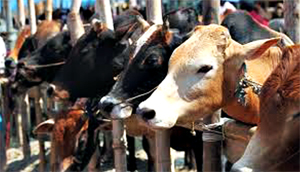The ban on cattle export by India proved to be a blessing in disguise. It brought opportunity to local farmers to raise more cattle and fatten them for Eid market. Despite speculation of a big crisis, local farmers were able to keep the supply steady and make handsome profit.
At the end the market did not feel the crunch, it did fairly well and buyers were also happy to find the sacrificial cattle within affordable price. What is more noticeable is that the occasion opened the confidence that Bangladesh can be able to supply its own market without Indian cattle.
India relaxed the ban at the end but the local market was already able to refocus its sourcing from local farmers who were however raising more cattle this year anticipating the crisis.
In fact preparations were afoot at least from early this year as soon as the Indian government made it known that they would restrict cattle export to at least double the prices of meat in local market.
Traders, farmers and hide merchants said a reduced inflow of cattle through illegal channels from India have helped local farmers to make good the supply shortfall which was always fulfilled by import from India.
The religious festival accounts for nearly half of the 80 lakh cattle slaughtered in Bangladesh a year, while illegal supplies from India meet up to 30 percent, according to traders and data from the National Board of Revenue.
However, the supply from India this year was lower than last year amid the Indian authority’s control over the entry of cows to Bangladesh, according to traders.
They said reduced inflow of cattle from India encouraged many people to fatten cows in the months leading up to Eid. This year, farmers fattened 30 lakh bulls for sale during Eid. In addition, nearly 12 lakh bulls reared by the farmers were also brought into the Eid markets, according to provisional estimates by Department of Livestock Services (DLS).
Farmers and traders said low prices of cattle a few days ago made many of them unhappy, but prices soared as Eid neared.
A cattle fattener from the northern district of Pabna said he brought 100 cattle to the market in the capital ahead of Eid. He sold all the animals at a margin. He said he was initially disappointed to sell some large bulls at lower than expected price.
But he was later able to sell the rest in line at his targeted price in the last few days ahead of Eid when some scarcity flashed out in the market.
It was a good year for cattle breeders, said a cattle fattener from Satkhira. He said keeping Indian cattle away from market will help local farmers to raise more cattle and it would pave the way to local self-sufficiency. Large scale import must be stopped, he said.
He said local breeders become nervous when Indian cattle enter the market in
large number. Bangladesh must close the border; he said adding local breeders have the potentials to meet the country’s annual demand for meat and dairy products.
The government should restrict the entry of Indian cattle for the sake of development of the local dairy and beef sectors, he said.
What is important is to make easy availability of bank credit at low cost and animal husbandry facilities at farmers’ door steps. Cattle is highly vulnerable to various diseases and large scale death and such other sufferings of animal can destroy the farmers.
He said that the government should ensure all support to small and marginal farmers, it should encourage them to set up cattle farm or rear animal at household level.
DLS Director General Ajay Kumar Roy told the media last week that local cattle werte able to meet more than 90 percent of the demand during Eid festival this year. “Farmers received higher prices than in the previous years, while buyers were not uncomfortable with the prices either.
Both buyers and sellers were happy. “It is a good sign for livestock development that locally reared cattle can meet a large portion of our requirement,” he said
However, Bangladesh Hide and Skin Merchants’ Association functionaries fear that fewer numbers of cattle were slaughtered this year mainly because of a reduced supply of cattle from India.
In his estimate the shortage ran from 5 to 6 lakh as the lower number of hide indicate after the Eid festival. Even if it was the net shortage, experts believe that Bangladesh has the potentials to make good this shortage.
Source: Weekly Holiday










